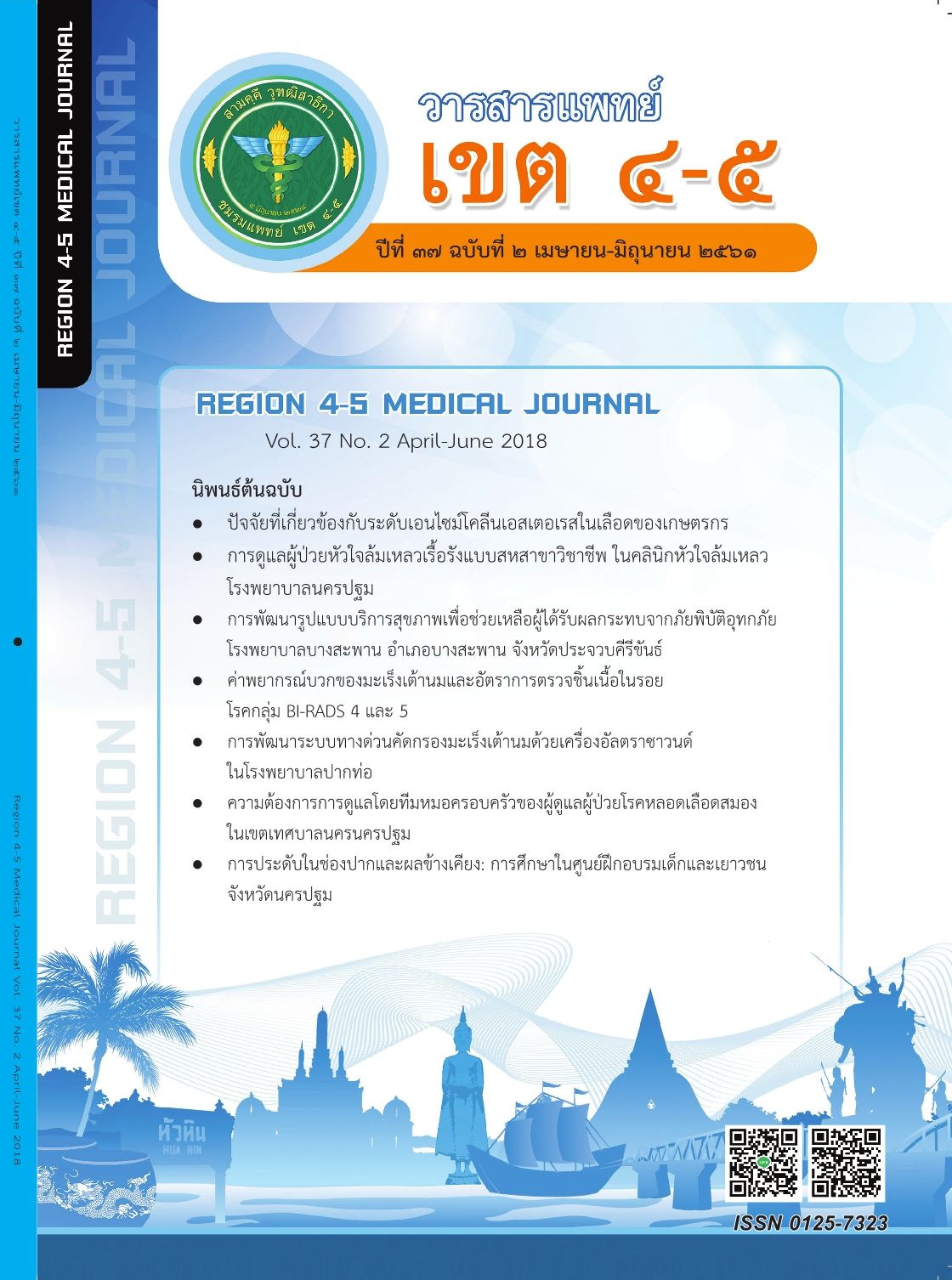ค่าพยากรณ์บวกของมะเร็งเต้านมและอัตราการตรวจชิ้นเนื้อในรอยโรคกลุ่ม BI-RADS 4 และ 5
คำสำคัญ:
แมมโมแกรม, มะเร็งเต้านม, ค่าพยากรณ์ผลบวก, อัตราการตรวจชิ้นเนื้อบทคัดย่อ
วัตถุประสงค์: เพื่อศึกษาค่าพยากรณ์บวกของมะเร็งเต้านม และอัตราการตรวจชิ้นเนื้อจากการรายงานผลแมมโมแกรมในรอยโรค กลุ่ม BI-RADS 4 และ 5
วิธีการศึกษา: ศึกษาย้อนหลังจากเวชระเบียนและรายงานผลแมมโมแกรมกลุ่ม BI-RADS 4 และ 5 ในโรงพยาบาลประจวบคีรีขันธ์ ตั้งแต่วันที่ 1 ตุลาคม พ.ศ. 2556 ถึง 31 ตุลาคม พ.ศ. 2560 โดยศึกษาหาค่าพยากรณ์ บวกของมะเร็งเต้านม ในผู้ป่วยหญิงที่มีการตรวจชิ้นเนื้อพร้อมผลรายงานทางพยาธิวิทยา และเปรียบเทียบการรายงาน ผลแมมโมแกรมกับผลพยาธิวิทยา รวมถึงอัตราการตรวจชิ้นเนื้อในรอยโรคกลุ่ม BI-RADS 4 และ 5
ผลการศึกษา: จำนวนผู้ป่วยที่ได้รับการตรวจแมมโมแกรมทั้งสิ้น 1,596 ราย พบผู้หญิงที่เข้าเกณฑ์ BI-RADS 4 และ 5 จำนวน 312 ราย มีผู้หญิง BI-RADS 4 และ 5 ที่ได้รับการตรวจชิ้นเนื้อทั้งสิ้น 195 ราย คิดเป็นร้อยละ 62.5 โดยเป็น BI-RADS 4 ร้อยละ 58.9 และ BI-RADS 5 ร้อยละ 75.8 ตามลำดับ อายุเฉลี่ย 50.1 ปี (อายุระหว่าง 26-85 ปี) ลักษณะภาพรังสีที่พบมากที่สุด คือ ก้อนที่ไม่มีหินปูน พบผู้หญิงที่เป็นมะเร็งเต้านมจำนวน 88 ราย ชนิดของมะเร็งเต้านมที่พบมากสุดในการศึกษานี้ คือ invasive ductal carcinoma โดยกลุ่มที่ไม่ใช่มะเร็งจำนวน 107 ราย พบ fibrocystic change มากที่สุด ค่าพยากรณ์ผลบวกของผู้หญิงมะเร็งเต้านมในกลุ่ม BI-RADS 4 ร้อยละ 27.6 และ BI-RADS 5 ร้อยละ 96.0
สรุป: การรายงานผลแมมโมแกรมแบบ BI-RADS มีประโยชน์ในการพยากรณ์โอกาสที่จะเป็นมะเร็งเต้านม และการตรวจชิ้นเนื้อมีความสำคัญในผู้ป่วยที่สงสัยมะเร็งเต้านมทุกราย เนื่องจากการรายงานผลแมมโมแกรม บางกรณีไม่สามารถแยกมะเร็งจากก้อนเนื้องอกธรรมดา โดยค่าพยากรณ์บวกของมะเร็งเต้านมผู้หญิง BI-RADS 4 และ 5 ในการศึกษานี้เท่ากับ ร้อยละ 27.6 และ 96.0 ตามลำดับ อัตราการตรวจชิ้นเนื้อภายหลังการรายงานผลแมมโมแกรมในการศึกษานี้ เท่ากับร้อยละ 62.5
เอกสารอ้างอิง
2. Hospital-based cancer registry. Bangkok: National Cancer Institute; 2015.
3. Kopans DB. Screening for breast cancer and mortality reduction among women 40-49 years of age. Cancer 1994;74:311-22.
4. Tabár L, Vitak B, Chen HH, et al. The Swedish two-county trial twenty years later. Updated mortality results and new insights from long-term follow-up. Radiol Clin North Am 2000;38:625-51.
5. American College of Radiology. Breast imaging reporting and data system, breast imaging atlas. 5th ed. Reston, VA: American College of Radiology; 2013.
6. Wiratkapun C, Bunyapaiboonsri W, Wibulpholprasert B, et al. Biopsy rate and positive predictive value for breast cancer in BI-RADS category 4 breast lesions. J Med Assoc Thai 2010;93:830-7.
7. Muttarak M, Srivichai K, Chaiwan B, et al. The breast imaging and data system-BIRADS: Positive predictive value of category 4 and 5 lesions. Chiangmai Med J 2010;49(3):111-6.
8. Sirikunakorn P, Marukatat M, Tangjitkamol S, et al. Positive predictive value of malignancy in BI-RADS 4 and 5 breast lesions. Vajira Med J 2014;58:1-11.
9. Yah-Yuan T, Siew-Bock W, Mona PC, et al. Positive predictive value of BI-RADS categorization in an Asian population. Asian J Surg 2004;27:186-91.
10. Zonderland HM, Pope TL Jr, Nieborg AJ. The positive predictive value of the breast imaging reporting and data system (BIRADS) as a method of quality assessment in breast imaging in a hospital population. Eur Radiol 2004;14:1743-50.
11. Lacquement MA, Mitchell D, Hollingsworth AB. Positive predictive value of the Breast Imaging Reporting and Data System. J Am Coll Surg 1999;189:34-40.
12. Wiratkapun C, Lertsithichai P, Wibulpholprasert B. Positive predictive value of breast cancer in the lesions categorized as BI-RADS category 5. J Med Assoc Thai 2006;89:1253-9.
ดาวน์โหลด
เผยแพร่แล้ว
รูปแบบการอ้างอิง
ฉบับ
ประเภทบทความ
สัญญาอนุญาต
ลิขสิทธิ์บทความเป็นของผู้เขียนบทความ แต่หากผลงานของท่านได้รับการพิจารณาตีพิมพ์ลงวารสารแพทย์เขต 4-5 จะคงไว้ซึ่งสิทธิ์ในการตีพิมพ์ครั้งแรกด้วยเหตุที่บทความจะปรากฎในวารสารที่เข้าถึงได้ จึงอนุญาตให้นำบทความในวารสารไปใช้ประโยชน์ได้ในเชิงวิชาการโดยจำเป็นต้องมีการอ้างอิงถึงชื่อวารสารอย่างถูกต้อง แต่ไม่อนุญาตให้นำไปใช้ในเชิงพาณิชย์




